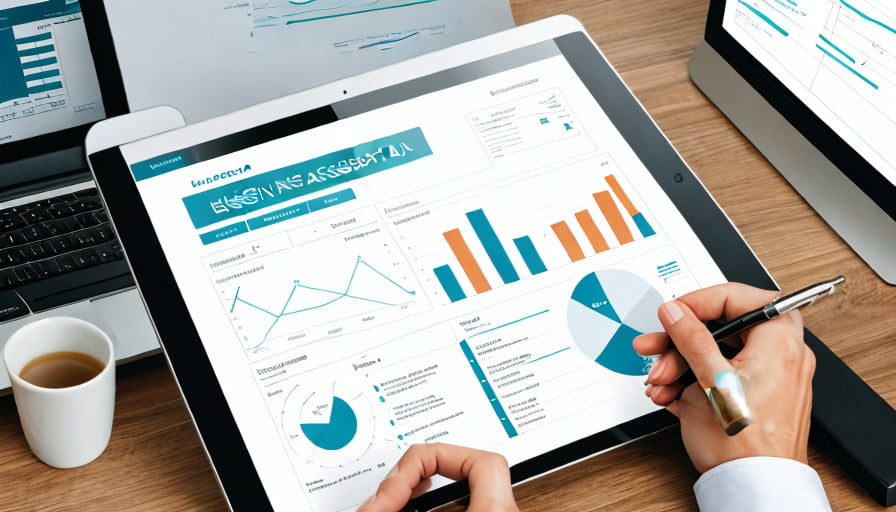A Business Planning Framework is a structured approach that helps organizations to systematically develop and implement their strategies. It provides a roadmap that outlines the steps needed to achieve the company’s goals and objectives.
There are several types of business planning frameworks, each serving different aspects of a strategic plan. For instance, the Ansoff Matrix is a strategic planning model that focuses on market penetration and potential future growth. It helps companies that aim to increase sales volumes or have it as a major focus area.
Another example is the IT Strategic Planning, which details how technology will help a company succeed in reaching its goals and objectives. It outlines where IT can do its part to implement a company’s strategies.
Strategic human capital planning is another type of business planning framework that focuses on how people — and how to manage them — align with the organization’s strategic goals. The end result is a plan to help attract and maintain the talent necessary to achieve the company’s mission and vision.
Business planning frameworks can be divided into two basic categories: traditional and lean startup. Traditional business plans are much longer and contain considerably more detail, while lean startup business plans use an abbreviated structure that highlights key elements.
The strategic planning process involves several steps, including setting strategy at the enterprise level, turning that strategy into action, and monitoring and reviewing the plans to ensure that issues are addressed and processes are realigned as necessary.
In conclusion, a business planning framework is a vital tool for any organization as it provides a systematic approach to strategic planning. It helps in setting clear goals, outlining the steps to achieve them, and monitoring progress towards these goals.
A Business Planning Framework is a structured approach to strategic planning that helps organizations develop and implement their strategies systematically. It provides a roadmap that outlines the steps needed to achieve the company’s goals and objectives a.
What Is a Business Planning Framework?
A Business Planning Framework is a structured approach that businesses use to develop strategic plans. It provides a systematic way to analyze and organize business goals and strategies, helping businesses to make informed decisions and achieve their objectives. This framework often includes various stages such as setting goals, developing strategies, implementing plans, and evaluating results.
Understanding the Importance of a Business Planning Framework
A Business Planning Framework is crucial for the success of any business. It helps businesses to:
- Set clear and achievable goals: A framework provides a platform for businesses to define their objectives and ensure they are specific, measurable, achievable, relevant, and time-bound (SMART).
- Develop effective strategies: By outlining how to achieve these goals, a framework helps businesses to create strategies that align with their overall vision and mission.
- Implement plans: The framework provides a roadmap for implementing these strategies, ensuring that all aspects of the business are aligned towards the achievement of the set goals.
- Evaluate results: Lastly, the framework allows businesses to evaluate their progress and make necessary adjustments to their strategies and plans.
Components of a Business Planning Framework
A typical Business Planning Framework includes the following components:
1. Business Environment Analysis
This involves understanding the external factors that can affect the business, such as market trends, economic conditions, competition, and technological changes. This analysis helps businesses to identify opportunities and threats, and to develop strategies that leverage their strengths and mitigate their weaknesses.

2. Internal Business Analysis
This involves assessing the business’s internal capabilities, such as its resources, capabilities, and structure. This analysis helps businesses to understand their competitive position and to develop strategies that leverage their internal strengths.
3. Goal Setting
This involves defining the business’s objectives and setting clear and achievable targets. The goals should be specific, measurable, and aligned with the business’s overall vision and mission.
4. Strategy Development
This involves developing strategies to achieve the set goals. The strategies should be realistic, feasible, and aligned with the business’s resources and capabilities.
5. Implementation Plan
This involves outlining how the strategies will be implemented. The plan should provide a detailed roadmap for achieving the set goals and should be aligned with the business’s resources and capabilities.
6. Evaluation and Control
This involves monitoring the progress of the implementation plan and evaluating the results against the set goals. The evaluation process helps businesses to identify any deviations from the plan and to make necessary adjustments to their strategies and plans.
In conclusion, a Business Planning Framework is a crucial tool for businesses to develop effective strategies, implement plans, and achieve their objectives. By providing a structured approach to planning, it helps businesses to make informed decisions, manage risks, and ensure their success.
The reasons for using a Business Planning Framework include:
- To Set Clear Goals: A business planning framework helps in setting clear, measurable, and achievable goals that align with the organization’s mission and vision.
- To Identify Opportunities and Threats: The framework often includes tools like SWOT analysis, which helps in identifying the organization’s strengths, weaknesses, opportunities, and threats. This helps in developing strategies to leverage opportunities and mitigate threats.
- To Align Strategies with Objectives: The framework provides a structured approach to aligning the organization’s strategies with its objectives. This ensures that all parts of the organization are working towards the same goals.
- To Monitor Progress: The framework includes mechanisms for monitoring and evaluating progress towards the strategic goals. This helps in identifying whether the strategies are effective and making necessary adjustments.
The Business Planning Framework should be put into play when there is a need to align the organization’s strategies with its objectives, identify opportunities and threats, set clear goals, and monitor progress. This is typically when the organization is starting a new project, launching a new product, or making significant changes in its operations.

As for which Business Planning Framework is good for which business, it depends on the nature of the business, its goals, and its operating environment. Some businesses may benefit from a traditional business planning framework that provides detailed plans and projections, while others may benefit from a lean startup framework that focuses on validating ideas and learning quickly.
It’s also important to note that a business can benefit from using multiple frameworks or tools, depending on its needs. For example, a business might use a SWOT analysis to identify opportunities and threats, and a Theory of Constraints framework to identify and address potential bottlenecks.
What are some common elements of a business planning framework?
A business planning framework typically includes several common elements that guide the strategic planning process. These elements serve as a roadmap for the organization to achieve its goals and objectives. Here are some of the most common elements:
- Mission and Vision Statements: These statements define the organization’s purpose and long-term goals. The mission statement outlines the organization’s reason for existence, while the vision statement describes the organization’s desired future state.
- SWOT Analysis: This tool helps the organization to assess its Strengths, Weaknesses, Opportunities, and Threats. This analysis provides valuable insights into the internal and external factors that could impact the organization’s performance.
- Strategic Goals and Objectives: These are the specific, measurable outcomes that the organization aims to achieve. They should be aligned with the mission and vision statements and be specific, measurable, achievable, relevant, and time-bound (SMART) .
- Action Plans: These are the detailed steps that the organization will take to achieve its strategic goals and objectives. Action plans should include specific tasks, timelines, and responsible parties.
- Resource Allocation: This involves determining how the organization’s resources, such as money, time, and personnel, will be allocated to achieve its goals and objectives. It’s crucial to ensure that resources are used efficiently and effectively.
- Monitoring and Evaluation: This involves tracking the progress of the action plans and evaluating their effectiveness in achieving the strategic goals and objectives. It’s important to adjust the plans as necessary based on the evaluation results.
- Key Partnerships: This involves identifying and outlining the relationships with other businesses or services that the organization will work with to achieve its goals.
- Value Proposition: This is a clear and compelling statement about the unique value that the organization brings to the market. It helps the organization to differentiate itself from its competitors.
These elements provide a comprehensive framework for business planning, helping organizations to stay focused and aligned towards achieving their strategic goals and objectives.
How often should a business planning framework be reviewed or updated?
The frequency of reviewing or updating a business planning framework can vary depending on the organization’s needs and the nature of its business. However, most organizations conduct a strategy review once a year, typically at the end of their annual cycle. This allows them to review the previous year’s results and identify elements that might need to be changed for the new year.
In some cases, if a significant change occurs within the organization, such as a change in leadership or a major shift in the business environment, it may be beneficial to conduct a review or update the business planning framework more frequently. This could be in the form of an ad hoc session to realign priorities and ensure the framework remains relevant and effective.

For business continuity plans, which are a part of the business planning framework, the review process should be continual, with different aspects being appraised and using various methods at least a few times a year. Many organizations strive for a schedule that includes a high-level check on each element of the plan twice a year, a verbal walk-through of the plan every other year, and a comprehensive review every other year.
In conclusion, while a yearly review is common, the frequency can be adjusted based on the organization’s needs and the pace of change within the business. Regular reviews ensure that the business planning framework remains aligned with the organization’s current goals and objectives, and allows for necessary adjustments to be made in response to changes in the business environment.
Common reasons for conducting a business planning framework review.
There are several common reasons for conducting a business planning framework review:
- To Evaluate Progress: Regular reviews allow the organization to assess the progress made towards achieving its strategic goals. This helps in identifying whether the current strategies are effective or if adjustments need to be made.
- To Identify Changes in the Business Environment: The business environment, including market trends, competitive landscape, and regulatory changes, can evolve over time. Regular reviews help in identifying these changes and adjusting the business planning framework accordingly.
- To Address New Opportunities or Threats: As the business environment changes, new opportunities and threats may emerge. Regular reviews allow the organization to identify these and incorporate them into its strategic planning.
- To Ensure Alignment with the Organization’s Mission and Vision: The business planning framework should be aligned with the organization’s mission and vision. Regular reviews help in ensuring this alignment and making necessary adjustments.
- To Identify and Address Issues: The business planning framework can help identify potential issues or bottlenecks that could impact the organization’s performance. Regular reviews allow these issues to be identified and addressed promptly.
- To Update Financial Projections: Financial projections are a key part of the business planning framework. Regular reviews ensure that these projections are up-to-date and accurate, reflecting the current financial situation and future expectations.
regular reviews of the business planning framework are crucial for ensuring that the organization remains aligned with its strategic goals, adapts to changes in the business environment, and makes necessary adjustments to its strategies and plans.
Tools or methodologies commonly used for conducting a business planning framework review.
There are several tools and methodologies commonly used for conducting a business planning framework review. These can help in assessing the current state, identifying areas for improvement, and setting a direction for the future. Here are a few:
- SWOT Analysis: This is a tool used to assess the Strengths, Weaknesses, Opportunities, and Threats related to the business. It helps in understanding the internal and external environment in which the business operates and makes strategic planning more effective.
- Scenario Modeling: This method is used to identify potential future situations or scenarios and develop strategies to address them. It helps in preparing the business for various possible outcomes and ensures that the business planning framework is flexible and adaptable.
- Theory of Constraints (TOC) Framework: This is a problem-solving framework that helps in identifying and addressing the constraints or bottlenecks that could be hindering the business. It can be used to uncover issues and risks that could impact the business and to develop strategies to overcome these constraints.
- Project Management Methodologies: Tools and methodologies from project management can also be used to conduct a business planning framework review. These include tools like Gantt charts for visualizing project timelines, Kanban boards for managing workflows, and Agile methodologies for iterative development and continuous improvement.
- Scenario Analysis and Contingency Planning: This process allows executives to explore and prepare for several alternative futures. It helps in anticipating potential risks and challenges and developing contingency plans to address them.
These tools and methodologies can provide a structured approach to conducting a business planning framework review, ensuring that the review is comprehensive and that the business planning framework remains aligned with the business’s current needs and future objectives. You should read another article i wrote about >>>>> Who Is a Business Planning Analyst? to learn more.
As an author writing and creating business courses and articles, I am responsible for developing and delivering high-quality content that is informative, engaging, and relevant to the target audience.
I monitor and analyzes business trends and topics to create courses and articles that provide value to readers and students here. I am responsible for ensuring that all content is accurate, well-written, and met the needs of the target audience.






